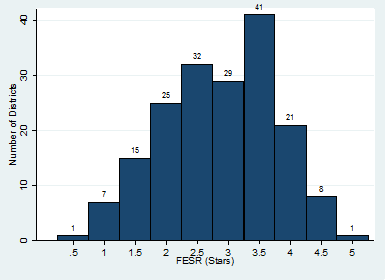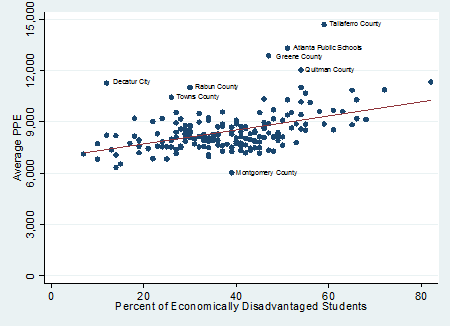
Analysis of the 2014-2015 District Financial Efficiency Star Ratings (FESR)
July 14, 2016
By Hannah Page and Pascal Beaudette
On July 14, the Georgia Department of Education (GaDOE) and the Governor’s Office of Student Achievement (GOSA) released the first Financial Efficiency Star Ratings (FESR).[1] The goal of the star rating is to provide a comparison of district spending per student with overall academic performance.
The rating is based on the district's three-year average College and Career Ready Performance Index (CCRPI) score and the percentile of the three-year average per pupil expenditure (PPE). The FESR should be one measure that stakeholders evaluate in conjunction with all other information provided for each district. This education update provides an overview of the FESR and presents summary information about this year’s rating. A downloadable file of the ratings by district is available
here
.
Key Findings
- One district (Forsyth County) received a five-star rating, and eight received 4.5 stars.
- One district (Talbot County) received one-half star, and seven received one star.
- Geographically, there is a concentration of districts receiving 4 or 4.5 stars in the area northeast of Atlanta and a concentration of districts receiving 1 to 1.5 stars in the southwestern portion of the state.
- Districts with a high percentage of economically disadvantaged students tend to have higher PPEs.[2] However, several districts with a high percentage of economically disadvantaged students have below average PPEs.
- The three-year PPE averages range from $6,000 to $14,700 and average around $8,465.
- The average PPE within the metropolitan area is $63 lower than outside of the metropolitan area, when Atlanta Public Schools is excluded.
FESR Overview
For the 2014-2015 school year, each school district in the state received an FESR to show the relationship between pupil spending and student achievement.[3] The matrix below shows the method for determining the FESR using both the PPE percentile and the CCRPI scores. Districts can earn between a one-half star and five stars, with a one-half star rating for districts with the highest PPEs and low CCRPI scores, and a five-star rating for districts with the lowest PPEs and high CCRPI scores. The 2014-2015 FESR is based on a three-year average (2012-2013, 2013-2014, and 2014-2015) of PPE and CCRPI scores.
Table 1: Star Rating Matrix

The PPE is calculated by dividing the district's expenditures by the district's fall enrollment count. The PPE calculation only includes certain expenditures. In general, expenditures that do not directly affect the K-12 population, those associated with facility construction, and expenditures that cannot be associated with a specific year are omitted from the PPE calculation. For a complete list of the excluded expenditures, please review the calculation guide.
2014-2015 Financial Efficiency Star Rating
The figure below shows the distribution of districts by percentile range and three-year average CCRPI score. At the ends of the FESR scale, only one district earned a one-half star, and one district earned five stars. Overall, districts averaged 2.9 stars.
Figure 1: Distribution of FESR

On the following map, districts are shaded according to their star rating. In the southwestern part of the state, there is a concentration of low-scoring districts, with four adjacent districts earning only one star. On the other end of the FESR range, a cluster of 4 to 4.5 stars is clustered around the north metro Atlanta area.
Figure 2: Map of Financial Efficiency Star Rating

Below are the school districts with the highest and lowest FESR ratings. Talbot County was the only district to receive the lowest star rating of a one-half star, and seven districts received the second lowest star rating of one star. On the upper-end of the scale, Forsyth County received five stars and eight districts received a star rating of 4.5 stars.
Table 2: Districts with Highest Star Ratings
| LEA | District FESR |
|---|---|
| Forsyth County | 5.0 |
| Bryan County | 4.5 |
| Chickamauga City | 4.5 |
| Columbia County | 4.5 |
| Gwinnett County | 4.5 |
| Jefferson City | 4.5 |
| Lowndes County | 4.5 |
| Pierce County | 4.5 |
| Schley County | 4.5 |
Table 3: Districts with Lowest Star Ratings
| LEA | District FESR |
|---|---|
| Talbot County | 0.5 |
| Calhoun County | 1.0 |
| Hancock County | 1.0 |
| Macon County | 1.0 |
| Quitman County | 1.0 |
| Randolph County | 1.0 |
| Taliaferro County | 1.0 |
| Twiggs County | 1.0 |
Patterns in Per Pupil Expenditures (PPE)
Because the PPE used in the FESR is different from other published PPEs, this education update presents summary statistics of this measure.[4] The three-year PPE average is $8,465.38. Over 74% of districts have an average PPE between $7,000 and $9,000. Seventeen districts have average PPEs above $10,000. Seven districts have average PPEs below $7,000. Figure 1 shows the distribution of the average PPEs.
Figure 3: Distribution of Average PPE

As seen in the following plot, there is a positive relationship between PPE and the percentage of economically disadvantaged students, meaning districts with a high percentage of economically disadvantaged students tend to have high PPEs.[5] However, several districts with a high percentage of economically disadvantaged students have below average PPEs.
Figure 4: Average PPE and Percentage of Economically Disadvantaged Students[6]

Metro and Non-Metro District Comparison
When districts in metro Atlanta and non-metro districts are compared, the non-metro districts have an average PPE approximately $300 less than districts in metro Atlanta.[7] However, the higher metro average is driven largely by Atlanta Public Schools (APS), which has the second highest average PPE ($13,297.39) in the state. When APS is excluded, the metro Atlanta average is $63 less than the average for the non-metro districts.
Table 4: Metro and Non-Metro District Comparison
| Total Districts | Average PPE | |
|---|---|---|
| Non-Metro Districts | 166 | $8,442.97 |
| Metro Atlanta Districts | 14 | $8,731.05 |
| Metro Atlanta Districts (without APS) | 13 | $8,379.92 |
Patterns in CCRPI
The total possible CCRPI score is 110 points (100 points and 10 Challenge Points). The index includes the following components[8]:
Table 5: CCRPI Component Breakdown
| CCRPI Component | Points Available in 2014-2015 CCRPI |
|---|---|
| Achievement | 50 |
| Progress | 40 |
| Achievement Gap | 10 |
| Challenge | 10 |
| Total | 110 |
The average district has a three-year average CCRPI score of 72.7; the lowest three-year average is 48.4 (Talbot County) and the highest is 90.4 (Forsyth County). Most districts (63%) have three-year average scores between 70 and 90.
Summary
Overall, the Financial Efficiency Star Rating provides a district-level measure of the relationship between per pupil spending and academic achievement, as measured by the CCRPI. Only Forsyth County received five stars, and eight districts received 4.5 stars. One district (Talbot County) received one-half star. The average district earned 2.9 stars. Geographically, there is a concentration of districts receiving 4 or 4.5 stars in the area northeast of Atlanta and a concentration of districts receiving 1 to 1.5 stars in the southwestern portion of the state.
[1] O.C.G.A. §20-14-33 requires that the Governor’s Office of Student Achievement (GOSA), in coordination with the Georgia Department of Education (GaDOE), create a financial efficiency rating. The law requires that GOSA and the GaDOE collaborate to “adopt and annually review, and revise as necessary, indicators of the quality of learning by students, financial efficiency, and school climate for individual schools and for school systems.” Financial efficiency “may include an analysis of how federal and state funds spent by local school systems impact student achievement and school improvement, and components used to determine financial efficiency may include actual achievement, resource efficiency, and student participation in standardized testing.” The rating must be based upon five stars.
[2] Historically, student eligibility for free/reduced-price lunch (FRL) served as a proxy for individual student/family income status. However, due to the recent expansion of the National School Lunch Program’s Community Eligibility Provision (CEP), FRL is no longer an accurate measure of student income status. For this reason, this education update uses directly certified students as a measure of poverty rather than FRL. For more information, click here to read GOSA’s education update on measures of student poverty.
[3] State schools (Atlanta Area School for the Deaf, Georgia, Georgia Academy for the Blind, and Georgia School for the Deaf) do not report their financial information separately using the Local Units of Administration Chart of Accounts. The state schools are operated by the Georgia Department of Education. Therefore, the financial activity of the state schools is reported in the State of Georgia Comprehensive Annual Financial Report but not in the data file used to calculate the FESR. As a result, these schools will not receive an FESR. Additionally, state charter schools do not receive a district rating.
[4] For information on the calculation of the PPE, please review the calculation guide.
[5] Directly certified students must either live in family units that receive Supplemental Nutrition Assistance Plan (SNAP) benefits or Temporary Assistance for Needy Families (TANF), and/or be homeless, unaccompanied youth, foster or a migrant.
[6] The same pattern holds when looking at only districts with an average PPE less than $12,000.
[7] The metro area is defined by the Atlanta Regional Commission as the ten-county metropolitan area. In addition to these districts, the following metro area city school systems are also included: Atlanta Public Schools, Buford City, Decatur City, and Marietta City Schools.
[8] For detailed information on these components, see this list compiled by GaDOE.